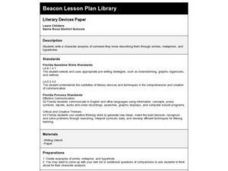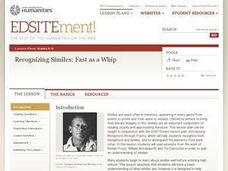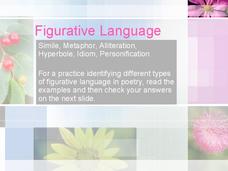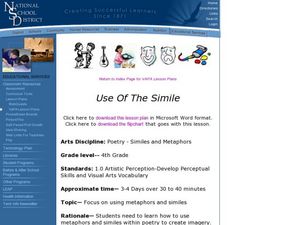Curated OER
Literary Devices Paper
Fourth graders write a character analysis of someone they know describing them through similes, metaphors, and hyperboles. They may include themselves and how their person relates to him or her.
Curated OER
"How to Eat a Poem"
Eighth graders write a poem showing what they know about metaphors, and non-literal language to express ideas, convey meaning, and create images after they read Eve Merriam's "How to Eat a Poem".
Curated OER
Recognizing Similes: Fast as a Whip
Students review basic knowledge of similes and engage with similes on a more abstract level. In this similes lesson, students define similes and identify examples. Students read and analyze the similes used in poetry by Derricotte,...
Curated OER
Describe a Journey
Students describe the sensory experience of a character's journey in an essay. In this precise details writing lesson, students explain the effects on the senses of weather, time of day, landscape, and other...
Curated OER
What is Figurative Language?
Need a review of literary terms and figurative language? Although text heavy, these slides clearly define frequently used terms and provide color-coded examples.
Curated OER
Figurative Language
I have a pair of ducks; one can’t swim. Viewers are introduced to several literary terms (paradox, oxymoron, pun, irony, etc.) that are defined and illustrated with examples. Then they are asked to identify the figurative language used...
Curated OER
Use of the Simile
Fourth graders identify and write their own similes. In this literary devices instructional activity, 4th graders define and identify similes. The teacher scaffolds the instructional activity so that all students can write their own...
Curated OER
Academic Vocabulary
Arm your writers with an arsenal of literary terms. With definitions of everything from plot structure and figurative language to point-of-view and types of irony, learners will gain an understanding of elements in stories and be able to...
New Vista Middle School
Hyperboles
Turn hyper bowls into hyperboles that will take away the breath of your principal and learners with the knowledge available in this presentation. The PowerPoint provides very clear and accurate information that breaks down how hyperboles...
Curated OER
Poetry
What is the difference between a simile and a metaphor? Third graders read a poem as a class and chart all of the similes and metaphors they hear. They then discuss the differences between each literary device as well as what is being...
Curated OER
ESL Network: Tezen, A Haitian Folktale
Sixth graders brainstorm various types of friendships prior to reading "Tezen," a tale about a young girl's friendship with a fish. After writing story reviews, they work in small groups to create dramatic skits based on the text and...
Utah Education Network (UEN)
Boxing and Analysis
Model for your high schoolers how to prepare for the essay portion of the AP Literature exam. For guided practice, pairs analyze metaphor, simile, tone or syntax in Norman Mailer’s “The Death of Benny Paret,” and then work independently...
Curated OER
Pictures in Words: Poems of Tennyson and Noyes
Students examine how Tennyson and Noyes use words to paint vivid pictures. They read and analyze two poems, complete an online scavenger hunt, complete a worksheet, and write examples of alliteration, personification, metaphor, simile,...
Curated OER
Pictures in Words: Poems of Tennyson and Noyes
Students analyze poems by Tennyson and Noyes. They identify examples of alliteration, onomatopoeia, personification, metaphor, and simile. Students create examples of alliteration, onomatopoeia, personification, metaphor, and simile.
Curated OER
Poetry: What's on Your Plate (Part 2)
Students write a short paragraph using strong descriptions. In this using modifiers lesson, students define modifier, adjective, adverb, metaphor, and simile. Students then write a journal entry in which they write about a...
Curated OER
Poetry Scrap Book
After your poets have compiled several written poems into a scrap-book, use this grading scale to explain how they'll be graded. The only guiding explanation of the assignment explains that they need to use two of the five literary...
Curated OER
Musical Poetry
Students analyze lyrics of their favorite songs as examples of alliteration, metaphor, Onomatopoeia, personification, rhyme, and simile to determine the purpose of these devices in poetry. They use their analysis to create a presentation...
Curated OER
Setting the Tone with Figurative Language
Explore figurative language with your secondary class. Extending a language arts unit, the lesson prompts middle schoolers to examine how an author's word choice establishes a story's tone, possibly using metaphors, similes,...
Curated OER
The Language of Surprise
Aspiring writers complete and discuss fill-in-the-blank cliché expressions, define cliché as a form of predictable writing, take cliché expressions and turn them into new, unpredictable ones, read poetry that illustrates writer's use of...
Curated OER
"The Story of an Hour" Lesson 3: Teacher's Guide and Notes
The third instructional activity in "The Story of an Hour" series introduces young readers to analogies; a literary device writers use to add depth to their stories. Instructors identify the three analogies in the tale, and class members...
Curated OER
Comments WERD
Students examine several examples of similes and metaphors, stating what is being compared. Then each student chooses a different person from the Civil War era and writes similes and metaphors that describe that person.
Curated OER
Simile Stories
Fourth graders view song lyrics and identify similes in the song text. In this similes lesson, 4th graders define and identify similes on a worksheet. Students write their own similes using various adjectives.
Curated OER
Identifying Figurative Language
Students explore Fahrenheit 451 by Ray Bradbury. For this figurative language lesson, students locate similes, metaphors, and examples of personification in their reading. Students write down the page numbers of each example...
Curated OER
The Secret Garden
Students explore plants in science and England as they synthesize data from the book, "The Secret Garden in this twelve lessons unit. Comparisons between the nuturing needs of plants and humans are made.
Other popular searches
- Similes and Metaphors
- Simile and Metaphors
- Poetry Similes and Metaphors
- Similes Metaphors
- Similes Metaphors Powerpoint
- Winter Simile and Metaphors
- Metaphors and Similes Test
- Using Similes and Metaphors
- Autumn Metaphors and Similes
- Similes and Metaphors Poem
- Poetry Similes Metaphors
- Poems Similes and Metaphors

























